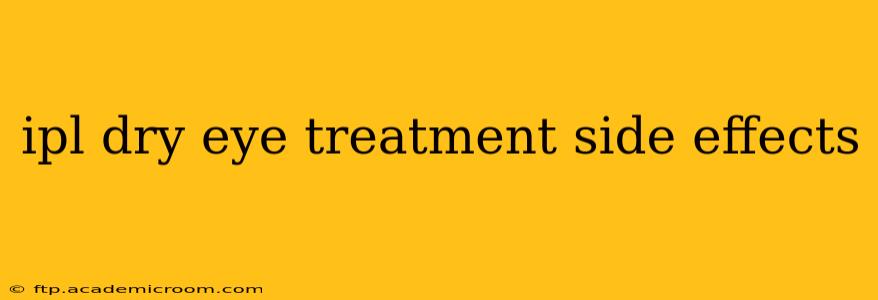Intense Pulsed Light (IPL) therapy is increasingly used as a treatment for dry eye disease, offering a potential solution for those struggling with chronic dryness, irritation, and discomfort. However, like any medical procedure, IPL treatment for dry eyes comes with potential side effects. Understanding these potential drawbacks is crucial for making an informed decision about whether this treatment is right for you. This comprehensive guide will delve into the common and less common side effects of IPL dry eye treatment, empowering you to have an open and honest conversation with your ophthalmologist.
What are the Common Side Effects of IPL Dry Eye Treatment?
Most patients experience minimal side effects, and those that do occur are usually temporary and mild. However, it's important to be aware of what might happen. The most frequently reported side effects include:
- Temporary redness and swelling: The treated area may appear slightly red and swollen for a few hours or days after the procedure. This is a normal response to the light energy and usually subsides quickly.
- Mild bruising: Some patients may experience minor bruising around the eyelids, again, typically resolving within a few days.
- Temporary darkening of the skin: In rare instances, the skin around the eyelids might temporarily darken. This usually fades over time.
- Increased sensitivity to light: You might find yourself more sensitive to bright light for a short period after treatment. Sunglasses can help alleviate this discomfort.
These side effects are generally manageable and shouldn't interfere significantly with daily activities.
What are the Less Common Side Effects of IPL Dry Eye Treatment?
While rare, some patients have reported more significant side effects. These include:
- Herpes simplex virus (HSV) reactivation: In individuals with a history of HSV (cold sores), IPL therapy might trigger a reactivation of the virus. This is why a thorough medical history is essential before undergoing the treatment.
- Burns: Though uncommon with experienced practitioners using appropriate safety measures, burns are a possible, albeit rare, complication.
- Infection: As with any procedure involving the skin, there's a small risk of infection. Maintaining good hygiene and following post-treatment instructions diligently can minimize this risk.
- Changes in skin pigmentation: While temporary darkening is common, persistent changes in skin pigmentation are less frequent but possible.
How Long Do Side Effects Last?
The duration of side effects varies from person to person. Most common side effects, such as redness and swelling, resolve within a few days. However, some, like minor pigmentation changes, might take several weeks to fully disappear. If you experience any persistent or worsening side effects, it's crucial to contact your ophthalmologist immediately.
What Can I Do to Minimize Side Effects?
Your ophthalmologist will provide specific post-treatment instructions, but generally, you can minimize potential discomfort by:
- Following all pre- and post-treatment instructions carefully. This includes any medications or preparations recommended by your doctor.
- Wearing sunglasses to protect your eyes from bright light.
- Applying cool compresses to reduce swelling and redness.
- Avoiding strenuous activities immediately after the treatment.
- Keeping the treated area clean and dry.
Is IPL Dry Eye Treatment Right for Me?
IPL therapy isn't suitable for everyone. Your ophthalmologist will assess your individual circumstances, including your medical history and the severity of your dry eye disease, to determine if it's the appropriate course of action. They will also discuss potential risks and benefits to help you make an informed decision.
What are the Alternatives to IPL for Dry Eye Treatment?
Many effective treatments for dry eye are available, including artificial tears, warm compresses, lid hygiene, and prescription medications. Your doctor will consider your specific needs and medical history when recommending a treatment plan.
How Many IPL Treatments Are Needed?
The number of IPL treatments required varies depending on individual responses and the severity of the condition. Typically, a series of treatments, spaced several weeks apart, is recommended to achieve optimal results. Your ophthalmologist will determine the appropriate treatment schedule for your situation.
This information is intended for general knowledge and informational purposes only, and does not constitute medical advice. It is essential to consult with a qualified ophthalmologist to discuss your specific situation, medical history, and suitability for IPL dry eye treatment. Remember, they are the best source of information regarding your individual case and can accurately address your concerns and questions.
